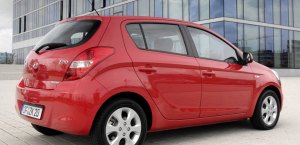|

|
Hyundai wants to challenge European
superminis with its European-designed and engineered new contender...
|
We have seen Kia Soul. Now
here
comes its sister car Hyundai i20. While the Kia is a tall-body and
fashion-driven hatchback, its Hyundai sister is a conventional
supermini aiming at Mr. Average who lives in Western Europe. It
replaces the outgoing Getz and, as its name suggested, ranks between
the A-segment i10 and C-segment i30. It is produced in Hyundai's
factory in India thus has a strong advantage in costs to its European
rivals like Ford Fiesta, Fiat Grande Punto, Renault Clio, Peugeot 107,
Volkswagen Polo, Seat Ibiza or its Japanese rivals like Honda Jazz,
Mazda 2 and Toyota Yaris. If it is adequately designed and engineered,
it just might be a strong contender in the class.
The i20 was styled and developed in Hyundai's European headquarters at
Russelsheim, Germany (near Opel). Its exterior design looks well done
and inoffensive, although you may criticize it as lacking character.
These days all car makers care about styling very much, so just well
done is not enough. You need some striking features to get attention
from the buying public. Unfortunately, Hyundai is playing safe in its
design direction. In contrast, its "younger brand", Kia, is doing much
more radical designs under the leadership of Peter Schreyer.

|
Well done is no longer enough when
everybody designs stylish cars these days...
|
The interior of i20 is similar. It's simple, clear and well layout, but
you hardly feel it special. Black is its main theme. Alloy-style
plastics cannot improve quality feel much. As limited by its Indian
suppliers, all plastics used in the cabin are hard ones. Switch gears
do not have the smooth operation as most European superminis. As a
result, the Hyundai never feels upmarket. What saves the game is again
cabin space, as Hyundai once again managed to give its car generous
dimensions out of less money. Wheelbase is a near class-leading 2525
mm, giving good legroom at the back.
Specification-wise, there is little to distinguish the chassis of this
car from European superminis. It also drives similarly on the road,
because it is tuned by mostly German engineers who used to work for
Opel. The car handles with little body roll and shows good stability at
high speed. The steering is accurate. However, its cheap tires transmit
a lot of harshness into the cabin over small irregularities. This ruins
its driving refinement.
 |
Limited by its Indian suppliers, its
cabin is full of hard plastics...
|
The Hyundai
group
offers quite a lot of choices of engines to i20. Petrol engines include
a new 1.25-liter 16V with 78hp, 1.4-liter 16V CVVT with 100hp and
1.6-liter 16V CVVT with 126hp, all of them employ lightweight aluminum
head and block construction. The smallest petrol might be slow, but not
so as the 1.2-liter 8V engine of Fiat Punto. Both 1.4 and 1.6 are
proved to be quite smooth and eager in other cars. Diesel engines
include 1.4-liter 16V common-rail injection turbo with 75hp or 90hp and
1.6-liter 16V common-rail injection turbo with 115hp or 128hp. The 90hp
1.4 turbo diesel is known to be unrefined, i.e., strong vibration at
idle and coarse at high rev, unlike the smooth and punchy 1.6 turbo
diesel.
Overall speaking, i20 is a stronger contender to the supermini class
than its predecessor Getz, but it won't stand out from the crowd unless
you look at its low price and long list of equipment. However, those
who purchase it should prepare to put up with its harsh ride (at least
before Hyundai sort out with new tires or suspension tweaks), lack of
driving fun, character and quality feel. |